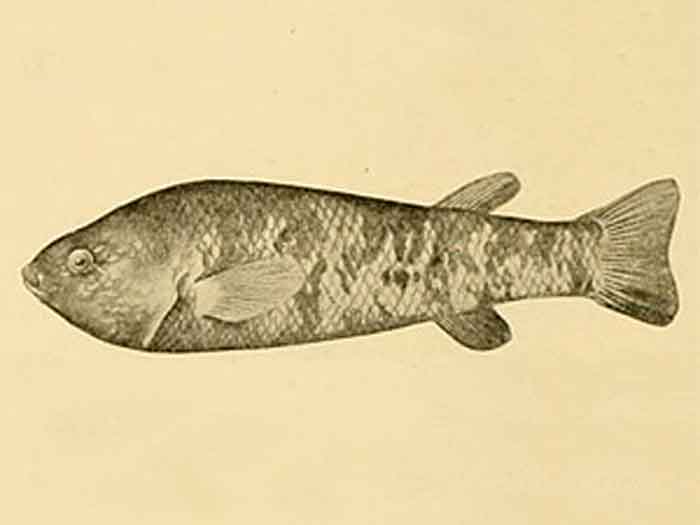Superregnum: Eukaryota
Cladus: Unikonta
Cladus: Opisthokonta
Cladus: Holozoa
Regnum: Animalia
Subregnum: Eumetazoa
Cladus: Bilateria
Cladus: Nephrozoa
Superphylum: Deuterostomia
Phylum: Chordata
Subphylum: Vertebrata
Infraphylum: Gnathostomata
Megaclassis: Osteichthyes
Superclassis/Classis: Actinopterygii
Classis/Subclassis: Actinopteri
Subclassis/Infraclassis: Neopterygii
Infraclassis: Teleostei
Megacohors: Osteoglossocephalai
Supercohors: Clupeocephala
Cohors: Euteleosteomorpha
Subcohors: Neoteleostei
Infracohors: Eurypterygia
Sectio: Ctenosquamata
Subsectio: Acanthomorphata
Divisio/Superordo: Acanthopterygii
Subdivisio: Percomorphaceae
Series: Ovalentaria
Superordo: Atherinomorphae
Ordo: Cyprinodontiformes
Subordo: Cyprinodontoidei
Familia: Goodeidae
Subfamilia: Empetrichthyinae
Genus: Empetrichthys
Species: E. latos – E. merriami
Name
Empetrichthys Gilbert, 1893
Gender: masculine
Type species: Empetrichthys merriami Gilbert, 1893, by monotypy.
References
Gilbert, C. H. (1893) Report on the fishes of the Death Valley expedition collected in southern California and Nevada in 1891, with descriptions of new species. U. S. Dept. of Agriculture. North American Fauna 7: 229–234, Pls. 5-6.
Links
Empetrichthys – Taxon details on Integrated Taxonomic Information System (ITIS).

Empetrichthys merriami
Empetrichthys is a genus of splitfins endemic to the state of Nevada in the United States. In 1989 they only had an estimated population of 24800, while its two other subspecies had gone extinct. This species mating season typically falls in spring. These animals are in danger and facing threats because their water is drying out because of pumping of ground water for agricultural developments.
Species
There are currently two recognized recent species in this genus of which only one is extant, in addition to one fossil species:[2]
Empetrichthys latos R. R. Miller, 1948
†Empetrichthys latos concavus R. R. Miller, 1948 (Raycraft Ranch poolfish)
Empetrichthys latos latos R. R. Miller, 1948 (Pahrump poolfish)
†Empetrichthys latos pahrump R. R. Miller, 1948 (Pahrump Ranch poolfish)
†Empetrichthys merriami C. H. Gilbert, 1893 (Ash Meadows poolfish)
†Empetrichthys erdisi (Jordan, 1924) (fossil, Miocene or Pliocene of California)[3][4]
References
Eschmeyer, William N.; Fricke, Ron & van der Laan, Richard (eds.). "Empetrichthys". Catalog of Fishes. California Academy of Sciences. Retrieved 17 September 2019.
Froese, Rainer; Pauly, Daniel (eds.). "Species in genus Empetrichthys". FishBase. August 2012 version.
Webb, Shane A.; Graves, Jefferson A.; Macias-Garcia, Constantino; Magurran, Anne E.; Foighil, Diarmaid Ó; Ritchie, Michael G. (2004-03-01). "Molecular phylogeny of the livebearing Goodeidae (Cyprinodontiformes)". Molecular Phylogenetics and Evolution. 30 (3): 527–544. doi:10.1016/S1055-7903(03)00257-4. ISSN 1055-7903.
Jimenez, Miguel; Goodchild, Shawn C.; Stockwell, Craig A.; Lema, Sean C. (2017-08-30). "Characterization and phylogenetic analysis of complete mitochondrial genomes for two desert cyprinodontoid fishes, Empetrichthys latos and Crenichthys baileyi". Gene. 626: 163–172. doi:10.1016/j.gene.2017.05.023. ISSN 0378-1119.
Retrieved from "http://en.wikipedia.org/"
All text is available under the terms of the GNU Free Documentation License

